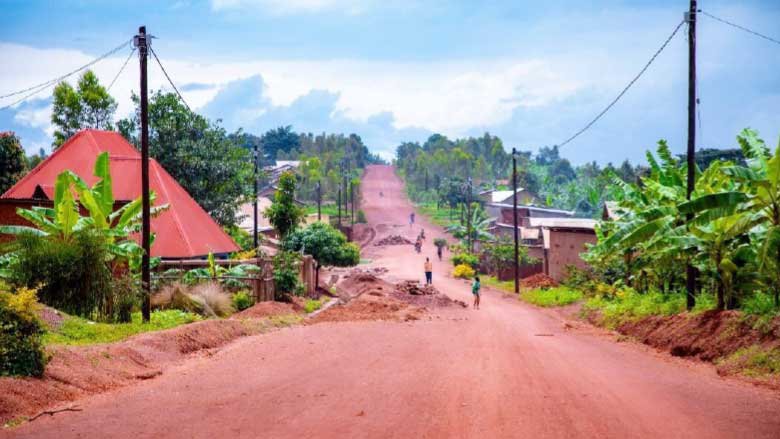The goal of lighting up every household is not a dream, but an achievable reality. In a remarkable 15-year journey, Rwanda increased access to electricity to households from 6% in 2009 to 75% as of March 2024. The country has connected 100% of health centers and administrative facilities at the sector level and 84% of schools and most productive users (micro, small, and medium-sized enterprises). This electrification expansion was one of the fastest in the world between 2010 and 2020, ranking 11th globally and 3rd in Africa.

A rural electrification project in Eastern Province, Rwanda.
Photo: Rwanda Energy Group
What did it take for Rwanda to achieve this, and what can other countries learn from this experience?
Government ownership, leadership, and commitment to universal electrification. Since 2008, the Government of Rwanda (GoR) has been intentional in engraining electrification targets in its development strategies. The Economic Development and Poverty Reduction Strategy 1 (EDPRS1 2008-2012) set out targets for electricity connections from 70,000 to 200,000 households, and for institutions providing social and administrative services from 50% to 80%. Likewise, both the EDPRS2 (2013-2018), and the National Strategy for Transformation 1 (2017-2024) set a universal electrification target by 2024.
An accountable and dedicated structure. The Electricity Access Rollout Program was set up in 2008 with a mandate to implement the government's spatial least-cost electricity investment program, anchored on an investment prospectus that integrates technical, financial, and implementation planning components. Following the sector reforms in 2013, the energy sector oversight, management, and operation became the primary responsibility of three institutions:
- Ministry of Infrastructure (MININFRA) for overall policy and strategy of the energy sector and coordination of the development of the electricity sub-sector,
- Rwanda Utilities Regulatory Authority to regulate energy resources, and
- Rwanda Energy Group (REG) which has two subsidiaries: Electricity Utility Corporation Limited for utility operations, and Energy Development Corporation Limited (EDCL) for planning, new energy development activities, and electrification rollout.
In addition, the government adopted policies to support the uptake of off-grid Solar Home Systems (SHS) through the private sector. It also mandated the Development Bank of Rwanda (BRD) to support EDCL by providing financial intermediary services through credit lines and results-based financing to scale up the rollout of SHS - recognizing the importance of the dual track of grid and off-grid electrification in speeding up electrification.
For accountability and performance monitoring, REG and EDCL management sign annual performance contracts (imihigo), committing to achieving the annual electrification targets.
Institutional strengthening and capacity building. EDCL has developed the capability to achieve electrification targets and continuously introduce flexibility through various rollout mechanisms to accelerate the pace of electrification. It is now self-sufficient in delivering long and short-term least-cost geo-spatial electrification plans, and is using a mix of international engineering, procurement and construction contractors and in-house and locally based contractors for grid extensions and last-mile connections. Additionally, BRD and EDCL have continued to support each other in advancing off-grid electrification, learning from experience, and continuously adapting a mix of strategies to support the private sector, including programs for affordability to fast-track off-grid electrification.
Funding availability and strong partnerships. Electrification rollout is expensive. It, therefore, requires sufficient funding and dependable partners. Concessional financing from development partners is the predominant source of funds for developing countries which, once secured, recipients should deploy efficiently. The GoR has intentionally formed strong partnerships with development partners and other relevant sector stakeholders. In 2008, the government, supported by the World Bank, worked with development partners to design the Energy Sector-Wide Approach (eSWAp). Its main objective is to enable expansion of access to electricity to meet Rwanda’s national targets. Under the eSWAP, the sector involves all relevant stakeholders in implementing the Economic Development and Poverty Reduction Strategy, including decisions related to sector strategies, planning, implementation, monitoring, and mobilizing of resources. A sector working group chaired by the Ministry of Infrastructure and co-chaired by development partners in rotation, comprising all relevant stakeholders, guides the eSWAP.
Since the first financing round table held in 2009, Rwanda has mobilized over $1.4 billion from different development partners for electrification, with approximately $750 million from the World Bank. The GoR provides counter-funds of up to 10% through the utility and is reinjecting beneficiaries' connection fees into the electrification program.
Involvement of the private sector: The GoR has involved the private sector in the rollout of off-grid SHS, connecting 22% of households through SHS. BRD and EDCL have designed funding mechanisms to support the private sector with capital requirements, paying close attention to the evolving realities and challenges and adjusting the program’s implementation in response. A Rwanda-pioneered pro-poor results-based financing program (implemented under the Renewable Energy Fund and the Energy Access and Quality Improvement Project) has successfully helped address affordability and proved successful in the fast-paced rollout of SHS.
Wholistic reforms. Following the structural energy sector reform in 2013, between 2017 and 2020, the government introduced several policies under the $475 million Rwanda Energy Sector Development Policy Operation to ensure fiscal prudence and sustainable electricity sector and service expansion. The policy changes included tariff reforms, least-cost geo-spatial planning along the electricity supply chain, policies to address affordability constraints, inclusion of off-grid in electrification planning, as well as the efficiency and accountability of the utility. As a result, Rwanda has maintained electricity sector subsidies below 1.4% of GDP while aggressively expanding electrification.
Rwanda's success in increasing access to electricity demonstrates that with the appropriate combination of ingredients, countries can accelerate their efforts to achieve universal electrification and meet Sustainable Development Goal 7 (SDG7), helping ensure affordable, reliable, sustainable, and modern energy to all.
